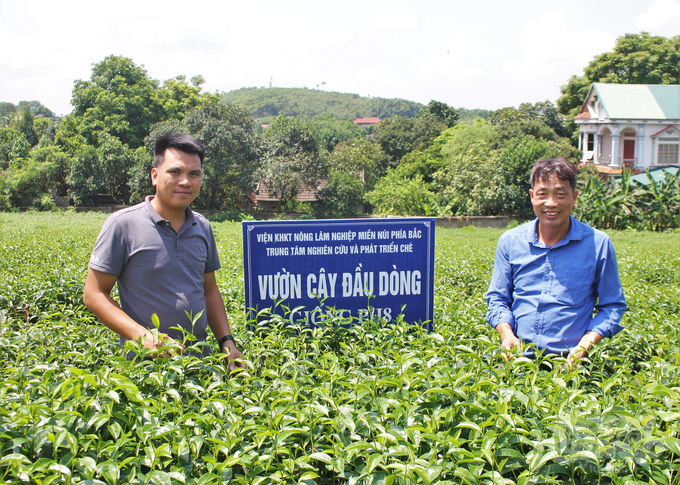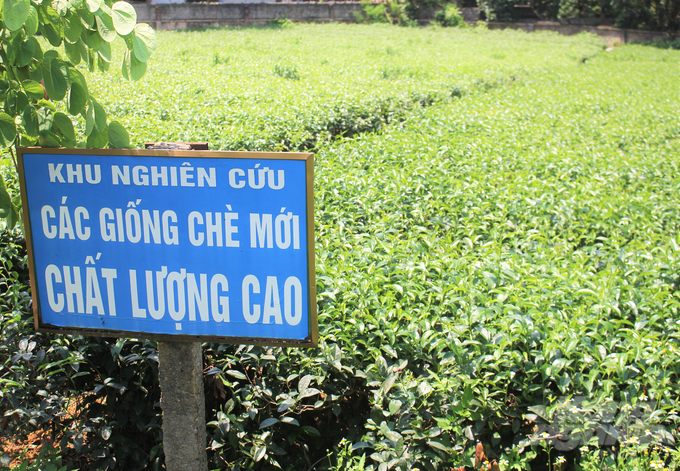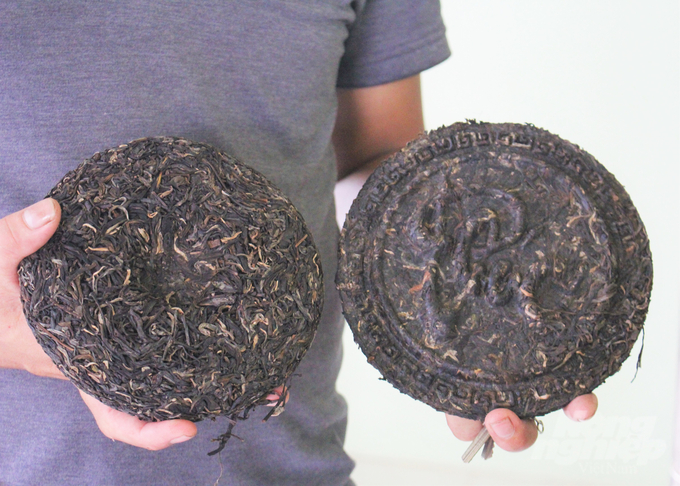The tea yield is above the world average
The Northern Mountainous Agro-Forestry Science Institute (abbreviated as NOMAFSI, under the Vietnam Academy of Agricultural Sciences) is the only unit in the country that conducts the study, collection, conservation and development of tea gene fund gardens.
In addition, one researches, selects, creates, tests and develops tea varieties that meet the requirements of production; Research, development of scientific bases, technical measures (cultivation, fertilization, plant protection…); Transferring and building an intensive farming model to increase the productivity, quality and improve the efficiency of tea production.

The Northern Mountainous Agriculture and Forestry Science and Technology Institute has “released” many sets of high-yielding, high-quality teas. Picture: Trung Quan.
dr Nguyen Ngoc Binh, deputy director of NOMAFSI, said that the institute researched, perfected and recognized six varieties of tea in the period 2018-2022, including HBS, TRI5.0, PH276, LP18, CNS141 and CNS183.
In implementation of the Law on Cultivation (valid from January 2020), on the basis of experimental production varieties researched and recognized in the previous phase, the Institute has carried out self-declaration procedures for the circulation of 6 varieties of tea, including PH21, VN15, LCT1, TC4, PH12, PH14. The institute has also made a name for itself and has been awarded nearly 17 hectares of leading orchards capable of providing seed production for the Vietnamese tea industry by the Ministry of Agriculture and Rural Development of Phu Tho Province.
The transfer of new tea varieties from the institute to production has grown quite rapidly, around 7 million varieties are traded annually with more than 20 partners across the country. In the period 2018 – 2021, the institute produced and delivered around 30 million seedlings. In particular, the new tea variety PH8 (recognized in 2015) after 7 years has grown strongly into production in the provinces of Phu Tho, Thai Nguyen, Son La, Tuyen Quang, Lai Chau, Nghe An… with an area of more than 4,600 ha.
In addition, tea processing technology research results have been transferred and applied to production practice in the northern midland and mountainous provinces such as Phu Tho, Son La, Thai Nguyen, Lai Chau, Bac Kan, Ha Giang, etc., contributing to the improvement of product quality and economy.

In the period 2018-2021, NOMAFSI has produced and delivered around 30 million tea seedlings for production. Picture: Trung Quan.
dr Nguyen Ngoc Binh added that the structure of tea varieties in the main tea-growing provinces across the country has recently undergone a major change. About 70% of this is black tea, the remaining 30% is used to make green tea products and other types of tea.
The new types of tea promoted by the provinces to replace the old ones have greatly changed the structure of tea products. While previously there were only two to three monotonous product lines, Vietnam’s tea products have become diverse and rich, encompassing many types such as black tea, fragrant green tea, green oolong tea, pressed cakes, red tea, white tea…
High-quality tea varieties, as well as specific cultivation techniques for each variety, have helped increase tea yields. According to statistics, Vietnam’s tea productivity has increased more than the world average (previously it was only 40-50% of world tea production). Currently there are tea varieties with a yield of 12-13 tons/ha/year. The total value from the application of new tea varieties is more than VND 1,500 billion/year…
Think of the tea gene fund as flesh and blood
NOMAFSI’s Tea Gene Fund Garden is currently collecting 406 genetic resources from locations across the country and many countries around the world such as India, Laos, Japan, Korea, Taiwan, China, etc. Tea genetic resources have been collected at locations there since 1918. This is an invaluable treasure for our tea industry. Because with this gene source it is possible to breed hundreds and thousands of different types of tea.
In order to preserve this valuable genetic resource, each staff member of the institute considers this gene pool group as their own flesh and blood, so every step is carried out very carefully. When the genetic resources show signs of degeneration and aging, they are cloned from the mother plant, then planted in a large pot, and then replanted so as not to lose the gene source.

The gene fund garden managed by NOMAFSI currently has 406 genetic resources collected from sites across the country and many countries around the world. Picture: Hoang Anh
From the garden’s genetic resources, the institute has bred about 2,000 individuals each year. Instances are still identified as directed and non-directed. Oriented individuals are grown directly on the mother tree or are free to harvest fruit on the mother tree (only the mother tree has excellent characteristics to bear fruit).
However, in order to be recognized as a variety, it must go through a very rigorous evaluation process that includes many stages of seed collection, planting, individual evaluation, line selection and evaluation, cloning and basic testing.
In the period 2019-2023, the Institute has opted to produce some very high quality teas such as VN15 and Huong Bac Son while protecting three teas including Huong Bac Son, LCT1 and TRI 5.0 (varieties produced by the mutagenesis method). The Huong Bac Son tea variety is able to process oolong tea to a better quality than the Kim Tuyen variety imported from Taiwan.
Hunting is like tea with the world
NOMAFSI not only has a variety testing area, but also has nearly 100 hectares of commercial tea plantations that provide raw materials for processing plants with a capacity of about 13 tons of raw materials per day.
This explains why the institute’s teas are successful in translating to local areas. Because the cultivation of raw tea is an attempt at tea varieties, accompanied by a large-scale care process, close to the actual production in tea regions. From this, the results, experiences, strengths and limitations of the variety and the cultivation process can be derived in order to make timely adjustments on site before transferring to mass production.

New high-quality tea varieties facilitate the diversification of products for the Vietnamese tea industry. Picture: Hoang Anh
Through many stages of development, NOMAFSI has made a very important contribution to the growth of Vietnamese tea industry, Dr. However, Nguyen Ngoc Binh is still of the opinion: Currently we have mastered the technology and are able to offer new types of tea for production. However, the tea industry always lags behind many countries in the world when it comes to breeding due to heavy investment in technology.
While we still diligently choose manual breeding due to lack of resources, many countries have employed genetic engineering and biotechnology. So when we created an equivalent new race, they created another new race. This puts us in a situation where we must always be on the lookout for types of tea. If we do not search for tea varieties, we will have limited competitiveness in opening up the international market…
Although NOMAFSI has extremely valuable tea genetic resources and hundreds of quality varieties, the research and conservation work encounters many difficulties due to limited funding.
Given these difficulties and demands of actual production, Dr. Nguyen Ngoc Binh that the research, selection and breeding of tea in the coming years must surely combine the use of traditional methods such as sexual hybridization, mutation and individual selection with modern methods such as the use of molecular biological technology and advanced technology to apply plant anatomy to tea breeding.
The focus is on the research and development of new tea varieties with high yield, good quality, drought tolerance and climate change response. Application of molecular biotechnology and biochemical technology to select and create new tea lines/cultivars with pest and disease resistance, high yield and good quality; Polyphenol-rich teas for the production of high-quality teas and functional foods…
In the NOMAFSI Tea Experimental Zone, numerous tea varieties are also tested, including: the varieties suitable for Oolong tea production (Kim Tuyen, Thuy Ngoc, Bat Tien, PH10, Huong Bac Son…); good green tea production varieties (LDP1, Phuc Van Tien, Hung Dinh Bach, Keo Am Tich, PH8, PH9..); good black tea production varieties (LDP2, PH11, PH12, PH14…).

